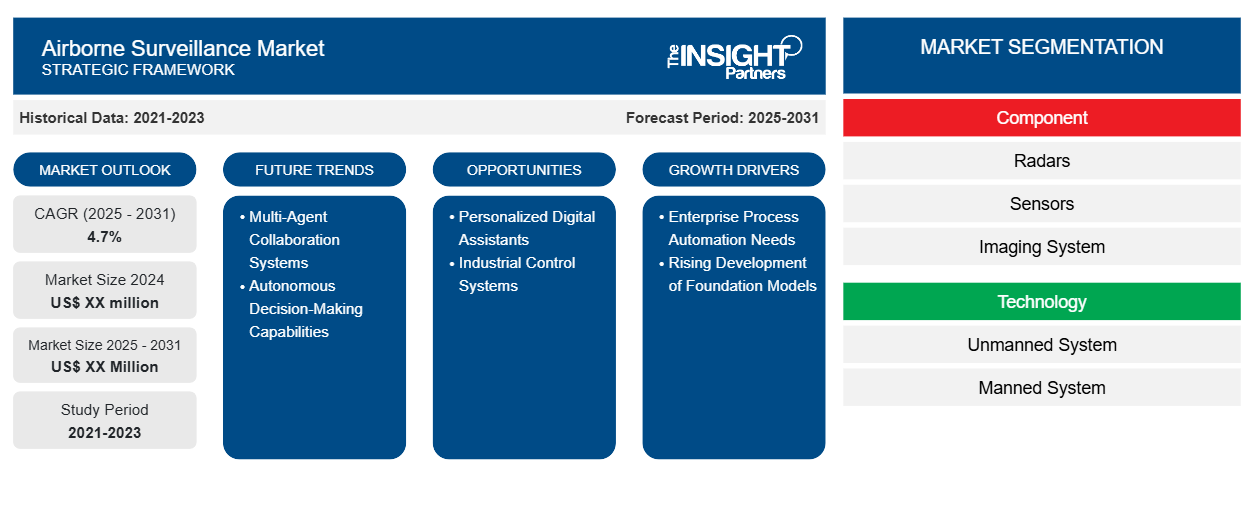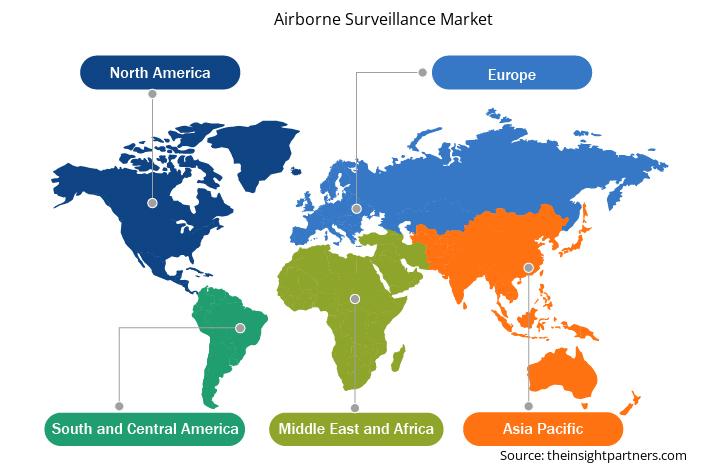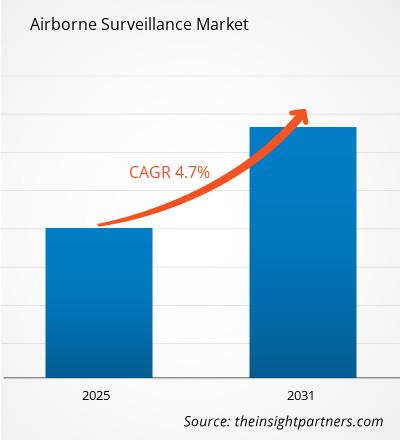预计机载监视市场在 2025 年至 2031 年期间的复合年增长率为 4.7%,市场规模将从 2024 年的 XX 百万美元扩大到 2031 年的 XX 百万美元。
该报告按组件(雷达、传感器、成像系统等)、技术(无人系统、载人系统)、平台(固定翼飞机、旋翼飞机、无人机)、应用[商业(农业和林业、检查和监测、工程、测量和制图、其他)、军事和政府(搜索和救援、执法、边境监视、ISR 目标定位)] 进行细分。全球分析进一步细分为区域和主要国家。报告提供了上述分析和细分的美元价值。
报告目的
Insight Partners 发布的《机载监视市场》报告旨在描述机载监视市场的现状和未来增长、主要驱动因素、挑战和机遇。该报告将为各业务利益相关者提供见解,例如:
- 技术提供商/制造商:了解不断变化的市场动态并了解潜在的增长机会,使他们能够做出明智的战略决策。
- 投资者:对市场增长率、市场财务预测以及整个价值链中存在的机会进行全面的趋势分析。
- 监管机构:规范市场政策和警察活动,旨在最大限度地减少滥用行为,维护投资者的信任和信心,维护市场的完整性和稳定性。
机载监视市场细分
成分
- 雷达
- 传感器
- 成像系统
技术
- 无人系统
- 载人系统
平台
- 固定翼飞机
- 旋翼飞机
- 无人机
应用
- 商业的
- 军事和政府
定制此报告以满足您的要求
您可以免费定制任何报告,包括本报告的部分内容、国家级分析、Excel 数据包,以及为初创企业和大学提供优惠和折扣
机载监视市场:战略洞察

- 获取此报告的顶级关键市场趋势。此免费样品将包括数据分析,从市场趋势到估计和预测。
机载监视市场的增长动力
- 企业流程自动化需求:业务运营日益复杂,降低运营成本的需求促使企业纷纷转向人工智能代理。企业正在寻求能够处理日常任务、客户互动和数据处理而无需人工干预的解决方案。人工智能代理能够全天候工作,比人类更快地处理信息,并高效地扩展运营规模,这对于希望简化工作流程的企业来说尤其具有吸引力。这种驱动力在客户服务、IT 运营和管理任务等领域尤为突出,因为这些领域需要自动化重复性流程,同时保持一致性和准确性。
- 基础模型蓬勃发展:GPT-4、Claude 和 PaLM 等基础模型的快速发展和普及,正在赋能更复杂的人工智能代理。这些模型为自然语言理解、推理和任务执行提供了基础能力,使人工智能代理能够应用于实际场景。随着基础模型功能更强大、计算效率更高,它们降低了开发人工智能代理的门槛,并拓展了其潜在用例。这些技术基础对于使代理能够理解上下文、做出决策并与人类自然交互至关重要。
机载监视市场未来趋势
- 多智能体协作系统:开发多个人工智能智能体协作解决复杂问题的系统正日益成为一种趋势。这些系统模仿人类的团队结构,不同的智能体专注于特定任务,并相互协调。例如,一个智能体可能负责数据分析,另一个智能体负责与用户的沟通,第三个智能体则负责监督任务的委派。这种方法对于需要不同专业知识和协调能力的复杂工作流程尤其有效,从而能够提供比单智能体系统更强大、更灵活的解决方案。
- 自主决策能力:人工智能代理的设计在决策过程中日益赋予其更高的自主性。这一趋势的标志是,代理不仅能够遵循预先设定的规则,还能从经验中学习并调整策略。这些代理具备复杂的风险评估能力,并能够在无需人工干预的情况下根据具体情况做出合适的决策。这种演变在算法交易、基础设施管理和供应链优化等领域尤为明显。
机载监视市场机遇
- 个性化数字助理:开发高度个性化的人工智能代理,能够深入理解个人用户的偏好、习惯和需求,拥有巨大的潜力。这些代理可以管理个人日程安排、处理沟通分类,甚至基于对用户行为模式的全面理解提出建议。此类个性化助理的市场已从消费级应用扩展到专业领域,它们可以显著提升个人生产力,平衡工作与生活。
- 工业控制系统:人工智能代理与工业控制系统的集成,为制造业和流程工业带来了重大机遇。这些代理可以优化生产流程、预测维护需求并实时管理资源分配。它们可以分析复杂的传感器数据,快速调整以保持最佳状态,并与其他系统协调以确保高效运行。随着各行各业迈向工业 4.0 和智能制造模式,这一机遇尤为宝贵。
机载监视市场区域洞察
Insight Partners 的分析师已详尽阐述了预测期内影响机载监视市场的区域趋势和因素。本节还讨论了北美、欧洲、亚太地区、中东和非洲以及南美和中美洲的机载监视市场细分和地域分布。

- 获取机载监视市场的区域特定数据
机载监视市场报告范围
| 报告属性 | 细节 |
|---|---|
| 2024年的市场规模 | XX百万美元 |
| 2031年的市场规模 | XX百万美元 |
| 全球复合年增长率(2025-2031) | 4.7% |
| 史料 | 2021-2023 |
| 预测期 | 2025-2031 |
| 涵盖的领域 | 按组件
|
| 覆盖地区和国家 | 北美
|
| 市场领导者和主要公司简介 |
|
机载监视市场参与者密度:了解其对业务动态的影响
机载监视市场正在快速增长,这得益于终端用户需求的不断增长,而这些需求的驱动因素包括消费者偏好的演变、技术进步以及对产品优势的认知度的提升。随着需求的增长,企业正在扩展产品线,不断创新以满足消费者需求,并抓住新兴趋势,从而进一步推动市场增长。
市场参与者密度是指特定市场或行业内企业或公司的分布情况。它表明特定市场空间内竞争对手(市场参与者)的数量相对于其规模或总市值而言。
在机载监视市场运营的主要公司有:
- 洛克希德·马丁公司
- L3Harris技术公司
- 诺斯罗普·格鲁曼公司
- Teledyne FLIR有限责任公司
- Reutech雷达系统
免责声明:以上列出的公司没有按照任何特定顺序排列。

- 获取机载监视市场顶级关键参与者概览
主要卖点
- 全面覆盖:该报告全面涵盖了机载监视市场的产品、服务、类型和最终用户的分析,提供了整体概况。
- 专家分析:本报告基于对行业专家和分析师的深入了解而编写。
- 最新信息:该报告涵盖了最新信息和数据趋势,确保了业务相关性。
- 定制选项:此报告可以定制以满足特定客户要求并适合业务策略。
因此,这份关于机载监视市场的研究报告有助于引领解读和理解行业现状及增长前景。尽管存在一些合理的担忧,但本报告的总体优势往往大于劣势。
- 历史分析(2 年)、基准年、预测(7 年)及复合年增长率
- PEST和SWOT分析
- 市场规模、价值/数量 - 全球、区域、国家
- 行业和竞争格局
- Excel 数据集
近期报告
客户评价
购买理由
- 明智的决策
- 了解市场动态
- 竞争分析
- 客户洞察
- 市场预测
- 风险规避
- 战略规划
- 投资论证
- 识别新兴市场
- 优化营销策略
- 提升运营效率
- 顺应监管趋势




















 获取免费样品 - 机载监视市场
获取免费样品 - 机载监视市场